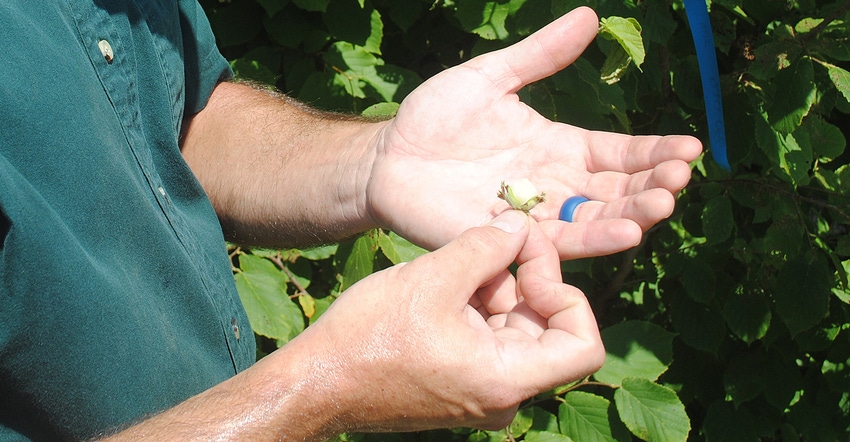September 4, 2018

Will hazelnuts become a forestry crop of the future on Great Plains and Midwestern farms?
Researchers in a collaborative effort between Oregon State University, Rutgers University, the Arbor Day Foundation and Nebraska Forest Service are looking into it.
At the Horning State Farm research facility near Plattsmouth, Neb., hundreds of hybrid and American hazelnut varieties are being tested for their adaptability to the weather, as well as resistance to disease and insect issues in the region.
Oregon wins the prize for hazelnut production in the U.S., annually harvesting almost 35,000 tons, with a total value of over $63 million. But other states including Minnesota, Wisconsin and Nebraska show potential for production based on research conducted using hybrid hazelnut varieties that cross the best aspects of European and American cultivars to develop a plant that has the nut quality and yield of the European hazelnuts combined with the cold-hardiness and disease tolerance of the American varieties.
That’s the work Aaron Clare, NFS forest properties manager at Horning State Farm, has been conducting. “To develop superior, reliable hybrid hazelnut cultivars for use in the Great Plains, Midwest and Fruit Belt, from the Great Lakes to the East Coast, we screen F1 and F2 progeny from crosses made at Oregon State and Rutgers for disease resistance against eastern filbert blight, cold- and heat-hardiness, nut quality, and yield,” Clare says. “They make crosses and send the seed to us to germinate, grow in the greenhouse and plant in the field in the fall.”
The first hazelnuts were planted at Horning Farm in 2007, with origins from Illinois, and the countries of Russia and Georgia. The hybrid hazelnuts were started in 2010. “Once we identify plants that are promising, we start taking notes on flowering times,” Clare says. “Hazelnuts have separate male, or catkins, and female flowers, and they open at different times. Also, the plants do not self-pollinate, so producers need to plant at least two pollen-compatible plants to ensure nut production. The timing of the catkin pollen shedding and female flower opening need to line up between the plants.” These aspects are documented before a plant can be released or patented.
The purpose of the trials is to get the positive nut traits from the European cultivars, like larger nuts with thinner shells and open husks where the nuts can drop from the tree for easy harvest off the ground. But the European varieties are susceptible to EFB, and are not as cold-hardy, especially the male flowers, Clare says. “We had a bunch of plants that were collected from the Black Sea region of Eastern Europe, and almost all died from either disease or climate,” he says.
While the American varieties that are being crossed in these trials are slower growing and smaller than their European counterparts, they do have the cold-hardiness and resistance to disease. “They like to sucker shoots from the roots and will grow together if you plant them closely,” Clare says. “The nuts are tiny, thick-shelled and have husks that clasp closed and are difficult to deal with.”
Beyond screening promising plants and moving selections to yield trials, the studies at Horning also test cultivation, harvesting and processing methods, as well as collect phenology data including plant size and flowering time.
“We still need to figure out what is best for commercial scale production,” Clare says. “We hope the next phase of testing with our collaborating farmers will help us identify what works best.”
Hazelnut varieties need to be farm-tested, and hazelnut co-ops and processing facilities are needed to develop an industry in regions where that doesn’t yet exist, Clare says.
You May Also Like




